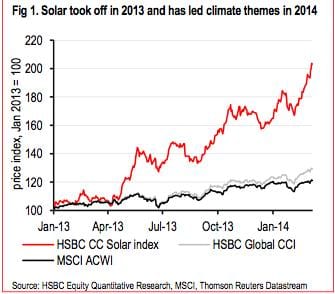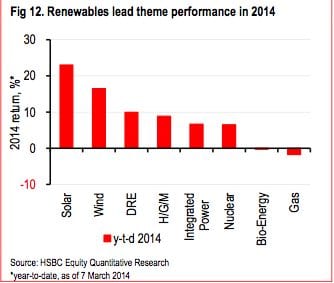Why Solar Beats Out Other Stocks

Sign up for daily news updates from CleanTechnica on email. Or follow us on Google News!
Originally published on RenewEconomy.
Solar stocks are certainly having their place in the sun, outperforming all other sub-indices in the global stock market to deliver the best returns over the past 15 months.
After “taking off” in mid 2013, the 32 stocks in the global solar index monitored by global investment bank HSBC gained 65 per cent in value for that calendar year and the index is already up 23 per cent in the first few months of 2014.
The 2014 return-to-date compares to 4.6 per cent for the HSBC Global Climate Change Index, and 0.7 per cent for the MSCI All Country World Index, one of the key global benchmarks. This graph below shows the comparative performance over the last 15 months.
HSBC says there are a bunch of reasons for solar’s strong showing: a combination of favourable policy initiatives in key markets, increased investment flows (public market investment doubled to $US6.3 billion in 2013), and stabilisation of prices of solar panels and attractive valuations. All of which have contributed to a supportive base for investors.
The over-riding theme – though – is that of grid parity. As HSBC notes, the price of solar continues to move further towards grid parity – at utility scale, not just at the socket – in many regions, making the technology more affordable and viable with less support from governments. That means it can continue to grow even when subsidies are finally removed.
 Between 2009 and 2014, HSBC estimates, the difference between the median levelised cost of electricity (LCOE) of solar and conventional coal has fallen by around 80 per cent. (See graph to the right). This, it notes, is a global average, and includes regions with lousy solar resources.
Between 2009 and 2014, HSBC estimates, the difference between the median levelised cost of electricity (LCOE) of solar and conventional coal has fallen by around 80 per cent. (See graph to the right). This, it notes, is a global average, and includes regions with lousy solar resources.
“The difference in the cost of electricity generated using solar power and electricity generated through conventional sources such as coal or natural gas also varies across regions,” it notes.
“HSBC equity research analysts believe that without considering the favourable effects of policies and supportive schemes, several states in the US and markets in Europe have already reached retail grid parity.”
It notes that Grupo Enerpro, a privately held Spanish company, developed and connected the country’s first unsubsidized 1MW utility-scale solar project to the grid and it plans to develop 10 further projects in 2014.
It also noted supportive policies in the workd’s three biggest economies – the US, China, and Japan – and in some key emerging markets such as Brazil, Peru and Chile.
Brazil recently conducted its first “solar auction” that allocated 123MW of capacity at an average price of $US97.80MWh, Peru has mandated solar for 500,000 off-grid homes by 2016, and Chile is the host of numerous large-scale solar projects, including the world’s largest “merchant” solar plant – a project built to sell electricity into the open market.
Despite all this, HSBC says solar stocks still look attractive – and offers an upside potential of 61 per cent based on long term relative price. In the graph to the right, the red line shows the potential upside on its trend adjusted price earnings estimates, while the grey line shows the upside based on its price-to-book valuations. Both are key metrics in the financial analysts world.
HSBC says another key factor is that finance for the solar market and the deployment of modules is being lubricated by the issue of “green bonds” and the floating of numerous “yield companies”, which offer attractive rates of return for investment in solar projects.
The solar market is forecast to grow 16 per cent a year, and the 12-month forward consensus earnings growth forecast for Global Solar is 87 per cent; driven mainly by 247 per cent earnings growth forecast for Asia-Pacific ex Japan and 153 per cent for the Asia-Pacific.
HSBC notes that while in 2013, its climate change index was dominated by the energy efficiency and energy management sub-sectors, it is the low-carbon energy production index that has taken the helm in 2014.
Apart from solar, the wind index has delivered a return of 16.5 per cent so far in 2014, while other renewables including Diversified Renewables and Hydro/Geothermal/Marine are up 9.9 per cent and 8.9 per cent, respectively.
Finally, Australian readers might be wondering, where is the opportunity for investors in Australian stocks? Well, good luck with that. No Australian stock marked the HSBC solar index. In fact, no Australian stock makes the HSBC climate change index – despite the fact that the Asia-Pacific region is the fastest growing, and best returning geographical region of its global index. As an investment slogan it might best be described as “Missed the Boat.”

Chip in a few dollars a month to help support independent cleantech coverage that helps to accelerate the cleantech revolution!
Have a tip for CleanTechnica? Want to advertise? Want to suggest a guest for our CleanTech Talk podcast? Contact us here.
Sign up for our daily newsletter for 15 new cleantech stories a day. Or sign up for our weekly one if daily is too frequent.
CleanTechnica uses affiliate links. See our policy here.
CleanTechnica's Comment Policy




